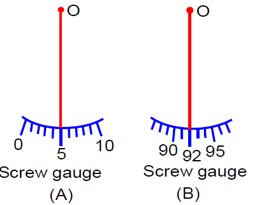Units and Measurement
Get insights from 125 questions on Units and Measurement, answered by students, alumni, and experts. You may also ask and answer any question you like about Units and Measurement
Follow Ask QuestionQuestions
Discussions
Active Users
Followers
New answer posted
2 months agoContributor-Level 10
ρ = m/ (4/3πr³). Δρ/ρ = Δm/m + 3Δd/d.
= 6+3*1.5=10.5%. (1050/100)%
New answer posted
2 months agoContributor-Level 10
using hook's law:
σ = Yε ⇒ f/A = Y (x/l) ⇒ Y = fl/ (xA) = fl/ (xπr²)
Using error analysis formula:
ΔY/Y = Δf/f + Δl/l + Δx/x + 2Δr/r
%error in Y = [ (Δm/m) + (Δl/l) + (Δx/x) + 2 (Δr/r) ] * 100
= [ (1/1000) + (1/1000) + (0.001/0.5) + 2 (0.001/0.2) ] * 100
= [ 0.001 + 0.001 + 0.002 + 0.01 ] * 100 = 1.4%
New answer posted
2 months agoContributor-Level 10
Δy/y = 2Δm/m + 4Δr/r + |x|Δg/g + (3/2)Δl/l
18 = 2 (1) + 4 (0.5) + |x|p + (3/2)4
18 = 2 + 2 + |x|p + 6 = 10 + |x|p
8 = |x|p
From the options, if x=8, p=±1. If x=16/3, p=±3/2. If x=5, p=±8/5. If x=4, p=±2.
Option B gives x=16/3, and p is not among the options.
Option A gives x=5, p not among options.
Option C gives x=8, p not among options.
Option D gives x=4, p not among options.
There must be a typo in the question or options. The solution gives x=16/3 and p=3/2. Let's check.
8 = (16/3) * (3/2) = 8. So B is correct.
New answer posted
2 months agoContributor-Level 10
[C] = Q/V = Q/ (W/Q) = Q²/W = (A²T²)/ (M¹L²T? ²) = M? ¹L? ²T? A²
[ε? ] = C/ (4πr²) * (Fr²/q²) = M? ¹L? ³T? A²
[µ? ] = 4πrF/I²l = M¹L¹T? ²A? ²
[E] = F/q = (MLT? ²)/ (AT) = MLT? ³A? ¹
New answer posted
3 months agoContributor-Level 9
Difference in Reading = Positive Zero Error - Negative Zero Error
= (+5) - [- (100-92)]
= 5 - [-8]
= 13
Taking an Exam? Selecting a College?
Get authentic answers from experts, students and alumni that you won't find anywhere else
Sign Up on ShikshaOn Shiksha, get access to
- 65k Colleges
- 1.2k Exams
- 679k Reviews
- 1800k Answers




